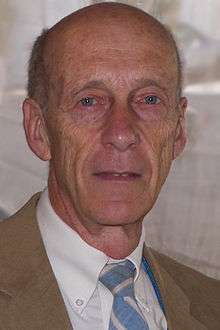Simon LeVay
| Simon LeVay | |
|---|---|
 Simon LeVay at the 2010 Texas Book Festival | |
| Born |
28 August 1943 Oxford, England |
| Alma mater |
University of Cambridge (B.A.) University of Göttingen (PhD) |
| Scientific career | |
| Fields | Neuroscience, Neurobiology, Human Sexuality |
| Institutions |
Harvard Medical School Salk Institute University of California, San Diego Stanford University |
Simon LeVay (born 28 August 1943) is a British-American neuroscientist. He is renowned for his studies about brain structures and sexual orientation.
Personal life
LeVay was born on 28 August 1943 in Oxford, England. He is openly gay.[1]
Education and career
- University of Cambridge, England (B.A., Natural Sciences, 1966)
- University of Göttingen, Germany (PhD, Neuroanatomy, 1971)
- Harvard Medical School (Postdoctoral Research Fellow, 1972–1974)
LeVay held positions in neurobiology at the Harvard Medical School from 1974 to 1984. He then worked at the Salk Institute for Biological Studies from 1984 to 1993 while holding an Associate Professorship in Biology at the University of California, San Diego. Much of his early work focused on visual cortex in animals, especially cats. In 2003 he was a lecturer and the Director of Human Sexuality Studies at Stanford University.
INAH3 research
In 1991, LeVay published "A difference in hypothalamic structure between heterosexual and homosexual men" in Science. This article reported a difference in average size between the third Interstitial Nucleus of the Anterior Hypothalamus (INAH3) in the brains of heterosexual men and homosexual men: INAH3 was more than twice as large in heterosexual men as in homosexual men. The INAH3 size of homosexual men was the same as that of women. LeVay wrote that "This finding indicates that INAH is dimorphic with sexual orientation, at least in men, and suggests that sexual orientation has a biological substrate." LeVay added, "The existence of 'exceptions' in the present sample (that is, presumed heterosexual men with small INAH 3 nuclei, and homosexual men with large ones), hints at the possibility that sexual orientation, although an important variable, may not be the sole determinant of INAH 3 size. It is also possible, however, that these exceptions are due to technical shortcomings or to misassignment of subjects to their subject groups."[2]
LeVay's finding was widely reported in the media.[3] LeVay openly related his research to his own homosexuality and to his mourning over his lover's death from AIDS.[4] LeVay cautioned against misinterpreting his findings in a 1994 interview: "It’s important to stress what I didn’t find. I did not prove that homosexuality is genetic, or find a genetic cause for being gay. I didn't show that gay men are born that way, the most common mistake people make in interpreting my work. Nor did I locate a gay center in the brain. The INAH3 is less likely to be the sole gay nucleus of the brain than a part of a chain of nuclei engaged in men and women's sexual behavior."[5] Some critics of LeVay questioned the accuracy and appropriateness of his measurements, observing that the structures are difficult to see in tissue slices and that he measured in volume rather than cell count.[6] Nancy Ordover writes that LeVay has been criticized for "his small sample size and for compiling inadequate sexual histories."[7]
Works
- LeVay S (1993). The Sexual Brain. Cambridge: MIT Press. ISBN 0-262-62093-6
- LeVay S, Nonas E (1995). City of Friends: A Portrait of the Gay and Lesbian Community in America. Cambridge: MIT Press. ISBN 0-262-12194-8
- LeVay S (1996). Queer Science: The Use and Abuse of Research into Homosexuality. Cambridge: MIT Press. ISBN 0-262-12199-9
- LeVay S (1997). Albrick's Gold. London: Headline Book Publishing. ISBN 0-7472-7687-0
- Sieh K, LeVay, S (1998). The Earth in Turmoil: Earthquakes, Volcanoes, and Their Impact on Humankind. New York: W.H. Freeman. ISBN 0-7167-3151-7
- Koerner, D, LeVay, S (2000). Here Be Dragons: The Scientific Quest for Extraterrestrial Life. Oxford: Oxford University Press. ISBN 0-19-512852-4
- Freed, C, LeVay, S (2002). Healing the Brain: A Doctor's Controversial Quest for a Cell Therapy to Cure Parkinson's Disease. New York: Times Books. ISBN 0-8050-7091-5
- LeVay S, (2008). When Science Goes Wrong, Plume. ISBN 0-452-28932-7
- LeVay S, Baldwin J (Fourth ed., 2012). Human Sexuality. Sunderland: Sinauer Associates. ISBN 0-87893-570-3
- LeVay S, Baldwin J, Baldwin J (Third ed., 2015). Discovering Human Sexuality. Sunderland: Sinauer Associates. ISBN 978-1-60535-275-6
- LeVay S, (Second ed., 2016). Gay, Straight, and the Reason Why: The Science of Sexual Orientation. New York: Oxford University Press. ISBN 9780190297374
- LeVay S, (2013). The Donation of Constantine: A Novel. Los Angeles: Lambourn Books. ISBN 978-1470132156
References
- ↑ "Allen, Garland E. "The Double-Edged Sword of Genetic Determinism: Social and Political Agendas in Genetic Studies of Homosexuality, 1940–1994." In Science and Homosexualities. Ed. Vernon A. Rosario. New York: Routledge, 1997. 243–270". Gendersex.net. 11 May 2011. Archived from the original on 14 October 2013. Retrieved 5 December 2013.
- ↑ LeVay S (1991). A difference in hypothalamic structure between homosexual and heterosexual men. Science, 253, 1034–1037.
- ↑ Angier, Natalie (30 August 1991). Zone of Brain Linked to Men's Sexual Orientation. New York Times
- ↑ Rosario, Vernon (1997). Science and Homosexualities. Routledge, ISBN 0-415-91502-3
- ↑ David Nimmons, "Sex and the Brain", Discover Magazine, March 1994, http://discovermagazine.com/1994/mar/sexandthebrain346/?searchterm=levay
- ↑ Barinaga, Marcia (30 August 1991). Is homosexuality biological? Science
- ↑ Ordover, Nancy (2003). American Eugenics: Race, Queer Anatomy, and the Science of Nationalism. University of Minnesota Press, ISBN 0-8166-3559-5
External links
| Wikiquote has quotations related to: Simon LeVay |